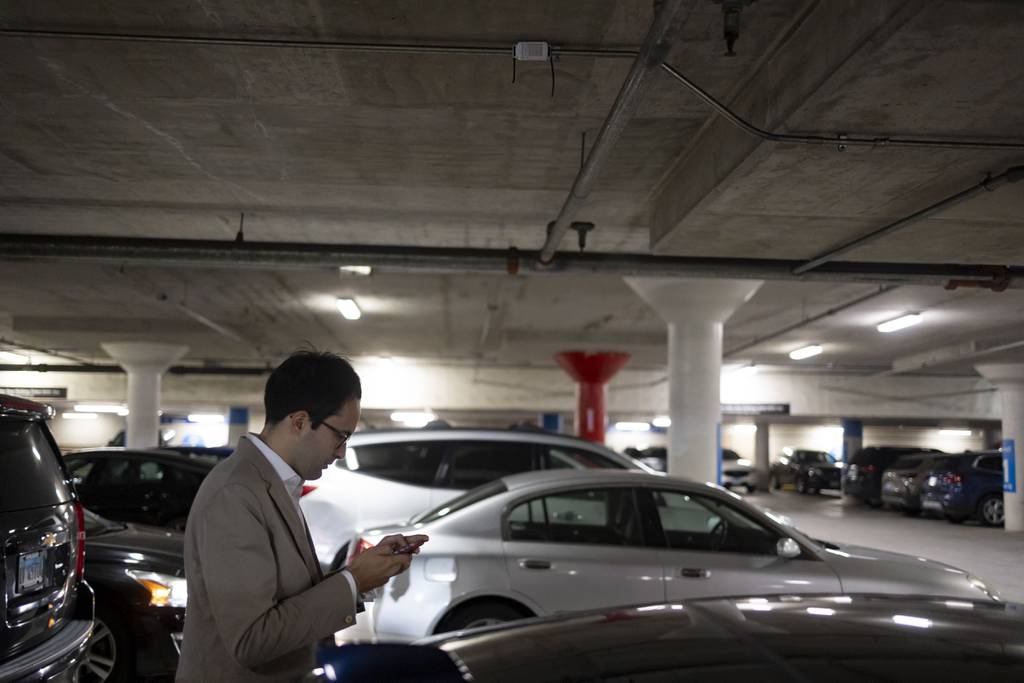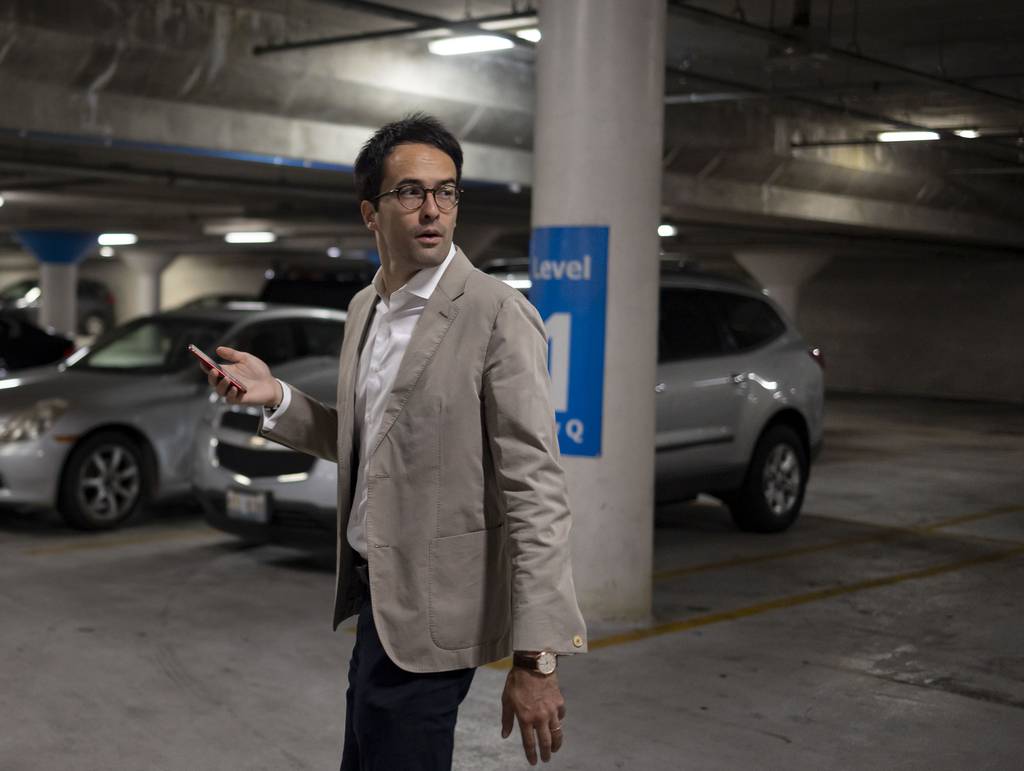Two levels below ground at the Grant Park North Garage, the summer heat feels oppressive. As downtown commuters park and exit their cars, sweat quickly beads on their furrowed brows and foreheads.
Alessandro Rotta Loria pinched two fingers to zoom into a map on his phone, trying to locate a temperature sensor. Finally, he found the white, pocket-size instrument, inconspicuously zip-tied to a pipe next to a red column.
Using a wireless network of more than 150 of these sensors above and below ground across the Loop, Rotta Loria, a Northwestern University assistant professor of civil and environmental engineering, discovered ground deformations in Chicago are causing buildings to sink and crack.
“Things are sinking very slowly,” Rotta Loria said. “The good news is that people don’t die.”
Buildings are unlikely to crumble because of underground climate change, he said, but damage from what he calls a “silent hazard” could lead to “tremendously” costly upkeep and retrofitting bills. And at the end of the day, he noted, sensible people tend to be uncomfortable with cracks in walls.
These deformations are occurring because of a phenomenon called underground climate change. Buildings, their garages and basements, as well as transportation systems like trains and tunnels, are constantly diffusing heat into the ground. The more of these packed into a given area, the higher the temperatures will be below the surface, causing the ground to contract and expand, Rotta Loria explained.
“This exploratory study is, to the best of my knowledge, the first of its kind. So a lot needs to be done to know more,” said Rotta Loria, whose study was published July 11 in the journal Communications Engineering. “This phenomenon is present in most, if not all, urban areas worldwide. It’s important to understand which types of civil structures and infrastructures are particularly sensitive to underground climate change and can be prone to operational issues.”
Local building developers and insurance professionals say they aren’t planning any changes to their buildings until more research has been conducted on underground climate change. But the study does explore promising ideas that could benefit sustainability efforts, especially as energy costs rise, they say.
Subterranean temperatures in Chicago’s downtown are likely not as high as they might be in more densely urbanized areas with bigger underground transportation systems such as London and New York City.
But the Millennium Parking Garage facilities, which include Grant Park North Garage and are touted as the largest downtown underground parking system in North America, presented a unique opportunity for research in Chicago’s busiest and densest infrastructural area.
Part of Rotta Loria’s research involved building a 3D computer model to simulate the evolution of ground temperatures since 1951 — when Chicago completed its subway tunnels — and predict it until 2051. These simulations demonstrated that higher temperatures can cause different types of soil like limestone and clay to either swell and expand upward by up to 0.47 inches or to contract and sink downward under a building by up to 0.31 inches.
By comparing data collected over three years from the sensors near underground infrastructures with data from sensors buried in green spaces like Grant Park, the researchers also found that underground temperatures beneath the Loop are often 18 degrees Fahrenheit higher than temperatures below Grant Park.
This means that not only do heat islands exist at the surface level in urban areas, where materials like steel, asphalt and concrete absorb more heat from the sun than rural or green areas do. They also happen underground, where they are known as subsurface heat islands, Rotta Loria said.

While both atmospheric and underground climate change are caused by humans, the cause of the former can be traced back mostly to heat-trapping greenhouse gas emissions due to fossil fuel burning. The latter is caused by heat from underground transit systems and buildings, but global warming and surface urban heat islands also contribute.
As part of his job at an insurance firm, Chris Semlies keeps up to date on climate-related risks that affect property and construction projects, something he notes is “intensifying.” Semlies said he doesn’t see an enhanced risk for underground structures such as parking garages.
But Semlies, the assistant vice president of Construction Project & Business Resilience Services for Zurich North America, said regular inspections to check for deterioration and cracks are essential.
Riverside Investment and Development finished building three office towers downtown in the past six years.
Tony Scacco, the chief operating officer of the Chicago-based real estate firm, said third-party experts haven’t recommended making any design changes based on the Northwestern findings, in large part because underground climate change doesn’t threaten a building’s structural integrity.
“We have not experienced any unforeseen conditions in basements or elevator pits or any subsurface levels as a function of excess expansion or contraction,” he said.
But Scacco said resiliency and sustainability are crucial in the design of new buildings, especially considering recent severe thunderstorms and flash flooding in Chicago. He said his firm tries to take “as little subsurface risk” as possible, which includes limiting the amount of excavation and not putting “critical facilities” underground.
Their main goal in terms of sustainability, Scacco said, is to reduce a building’s energy consumption. Sometimes that means using high-performance materials so heating and cooling costs decline. Other times, he said, his firm opts for building green roofs to reduce the heat island effect.
Rotta Loria’s research might offer a new approach to sustainability as well. In it, he suggests that urban planners can harvest waste heat with geothermal technologies and pump it into buildings as a heat source.
“Geothermal energy is a very powerful energy source, because it’s available continuously, everywhere on Earth, irrespective of the weather,” Rotta Loria said. “If you consider the energy budget of buildings, for example, residential buildings, depending on the country, from 40 to 70% of what we consume in buildings is associated with thermal energy.”

Naturally occurring geothermal energy, produced by the Earth’s core and stored in its crust, in conjunction with the waste thermal energy from poorly insulated buildings, can theoretically meet that demand, he said. “This is why the so-called geothermal potential of cities is actually enhanced,” he added.
Amy Masters, director of government and external affairs at the Building Owners and Managers Association of Chicago, sees thermal energy as a chance to increase operational efficiency and save on energy costs. BOMA is a trade association representing Chicago’s office building industry.

Afternoon Briefing
Weekdays
Chicago Tribune editors’ top story picks, delivered to your inbox each afternoon.
“Definitely more research is needed, and ultimately we will need more technology to evolve to actually be able to implement it,” she said.
Semlies said another one of Rotta Loria’s recommendations — that planners install thermal insulation in buildings to minimize the amount of heat entering the ground — is a good one. He added that building codes typically require insulation underground.
“Those codes exist for energy conservation purposes, but they would also mitigate losing heat from the building out into the surrounding soils,” Semlies said.
Rotta Loria said he plans to keep the sensor network up and running for the foreseeable future and continue collecting data. But he said the study’s three-year time frame has been helpful in beginning to understand the existing correlation between temperatures underground and at the surface.
“If you know what the temperature at the surface is, you can predict what the temperature (underground) is,” he said. “I don’t expect that for a longer period of time those correlations will change.”






